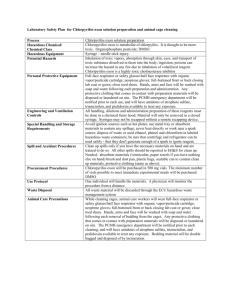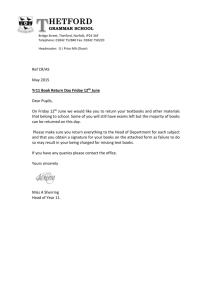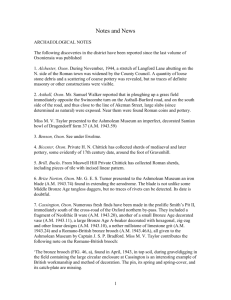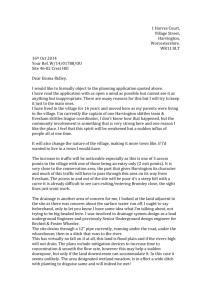Notes and News
advertisement
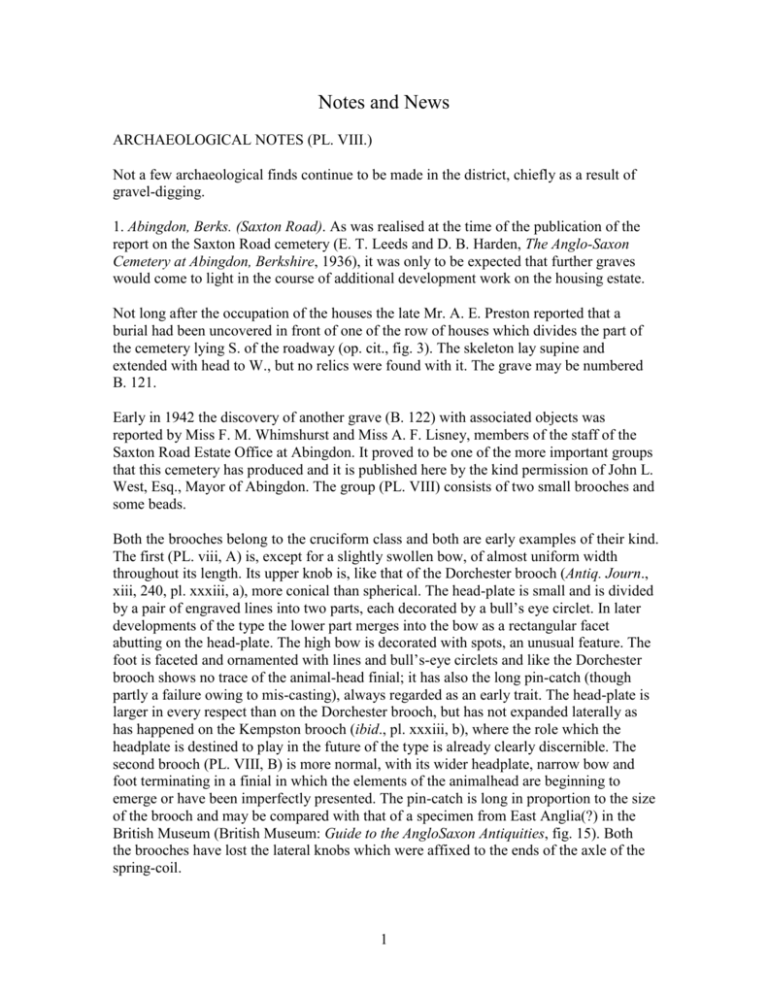
Notes and News ARCHAEOLOGICAL NOTES (PL. VIII.) Not a few archaeological finds continue to be made in the district, chiefly as a result of gravel-digging. 1. Abingdon, Berks. (Saxton Road). As was realised at the time of the publication of the report on the Saxton Road cemetery (E. T. Leeds and D. B. Harden, The Anglo-Saxon Cemetery at Abingdon, Berkshire, 1936), it was only to be expected that further graves would come to light in the course of additional development work on the housing estate. Not long after the occupation of the houses the late Mr. A. E. Preston reported that a burial had been uncovered in front of one of the row of houses which divides the part of the cemetery lying S. of the roadway (op. cit., fig. 3). The skeleton lay supine and extended with head to W., but no relics were found with it. The grave may be numbered B. 121. Early in 1942 the discovery of another grave (B. 122) with associated objects was reported by Miss F. M. Whimshurst and Miss A. F. Lisney, members of the staff of the Saxton Road Estate Office at Abingdon. It proved to be one of the more important groups that this cemetery has produced and it is published here by the kind permission of John L. West, Esq., Mayor of Abingdon. The group (PL. VIII) consists of two small brooches and some beads. Both the brooches belong to the cruciform class and both are early examples of their kind. The first (PL. viii, A) is, except for a slightly swollen bow, of almost uniform width throughout its length. Its upper knob is, like that of the Dorchester brooch (Antiq. Journ., xiii, 240, pl. xxxiii, a), more conical than spherical. The head-plate is small and is divided by a pair of engraved lines into two parts, each decorated by a bull’s eye circlet. In later developments of the type the lower part merges into the bow as a rectangular facet abutting on the head-plate. The high bow is decorated with spots, an unusual feature. The foot is faceted and ornamented with lines and bull’s-eye circlets and like the Dorchester brooch shows no trace of the animal-head finial; it has also the long pin-catch (though partly a failure owing to mis-casting), always regarded as an early trait. The head-plate is larger in every respect than on the Dorchester brooch, but has not expanded laterally as has happened on the Kempston brooch (ibid., pl. xxxiii, b), where the role which the headplate is destined to play in the future of the type is already clearly discernible. The second brooch (PL. VIII, B) is more normal, with its wider headplate, narrow bow and foot terminating in a finial in which the elements of the animalhead are beginning to emerge or have been imperfectly presented. The pin-catch is long in proportion to the size of the brooch and may be compared with that of a specimen from East Anglia(?) in the British Museum (British Museum: Guide to the AngloSaxon Antiquities, fig. 15). Both the brooches have lost the lateral knobs which were affixed to the ends of the axle of the spring-coil. 1 NOTES AND NEWS The beads (PL. viii, e), twenty in number, all but one of oblate form, are a mixed group. Seven are of clear greenish glass; three are of opaque red glass paste; four of the same red have inlays of spots within trellised lines, white in green (2), green in white and white in white; one, brown in colour, also has white in white; one, black, has a deep wavy white line; two, white, have spiral red lines, as also has the large four-lobed piece. The group may fairly be dated to the close of the 5th century and thus affords further evidence of an early occupation of this part of the upper Thames valley, towards which the main excavations had already contributed so much. 2. Barton (Headington), Oxon. A small circular lead ‘fairing’ in the form of a clock dial (17th century), found in digging an allotment, has been presented to the Ashmolean Museum. 3. Cassington, Oxon. (a) Purwell Farm. For an Iron Age settlement-site and a Saxon cemetery here, see above, pp. 62 ff. (b) Smith's Pit II. This gravel-pit is extending very rapidly into the area covered by the ring-ditches and the R.-B. occupation-site within the enclosure-ditch (see pp. 104 ff.; Oxoniensia, vi, 84), a portion of which has already been bodily removed. Little could be done to mitigate such wholesale destruction, but a quantity of Belgicised and R.-B. coarse ware was salvaged with the help of Mr. Partridge. A small fragment of flue-tile, the upper stone of a quern and a bronze fibula (1st-2nd century A.D.) were also found, but there are no conclusive signs here as yet of more pretentious R.-B. dwellings than timber huts. 4. Eynsham, Oxon. (Foxley Farm). Extension of the gravel-pit W. and NW. has revealed no further beaker burials (see Oxoniensia, iii, 23). 5. Hatford, Berks. Additional Iron Age A2 sherds have been collected by PilotOfficer D. N. Riley, including the shoulder of a carinated bowl with stroke-filled triangles of characteristic Wessex-A type, also a La Tene glass bead, blue with small white circles. 6. Radley, Berks. (Barrow Hills). Thanks to the careful observation of PilotOfficer D. N. Riley, it was possible for the Oxford University Archaeological Society to examine the centre of Barrow 15 (see plan, Oxoniensia, iii, 32,fig. 7) with its two concentric ditches, before it could be damaged by the extension of the old gravel-pit nearby. The maximum dimensions of the outer ditch were 2 ft. in depth and 5½ ft. in width. The inner ditch was about 2 ft. deep and 2 ft. wide, though in passing over conglomerate in the gravel it shrank to a mere ritual furrow. The primary burial lay in a rectangular pit (10 ft. by 5 ft.) about 2½ ft. deep in the gravel. There was some evidence that the tibia and fibula of both legs had been dismembered after partial desiccation. A carbonised log or plank of oak, now about 8 ins. across and 4 ft. long, lay down the middle at a depth of 2 ft. There was a secondary burial of two infants in another pit near the centre. A group of six or eight probable post-holes, 2 ft. N. of the primary burial was examined, but there was no 2 NOTES AND NEWS evidence of function or date. The only small find in the Barrow was a flint arrow-head at the bottom of the pit containing the primary burial. 7. Standlake, Oxon. In gravel-pit A (for the position of the gravel-pits and ringditches see Antiq. Journ., xxii, 208) circle no. 13 was destroyed before its examination (see Oxoniensia, vi, 88) could be concluded. Two new gravel-pits have been opened. The first is now about l00 yds. N. of circle no. 6, and is so far negative. The second has exposed sections of two ringditches (see Antiq. Journ., xxii, 208, fig. 2, no. 7) which showed that the bank, as is usual, lay outside the ditch. One of these ring-ditches was first identified by Stephen Stone in 1858 in the standing corn; both appear on Major Allen’s air-photographs. From, this gravel-pit a neat little vessel, c. 5½ ins. high, a small counterpart of the overhanging-rim urn (Middle Bronze Age) was secured by Dr. P. L. Collignon and presented by him to the Ashmolean Museum in 1941. 8. Stanton Harcourt, Oxon. (a) Beard Mill. A new gravel-pit is being worked close to the river Windrush, on the S. side of the road to Beard Mill (O.S. 6-in. Oxon. 38 W.) R.-B. coarse ware was found in two broad, shallow, contiguous depressions not far from the road. In the filling of one of them lay several Anglo-Saxon sherds with stamped ornament and some coarse ware. About 300 yds. SE. R.-B. sherds were also found in several storage-pits. (b) Linch Hill. The well-known gravel-pit here (Oxoniensia, i, 201 and ii, 202) has been extended northwards and R.-B. pottery is now appearing in some quantities. E. T. LEEDS; J. S. P. BRADFORD. THE CAMPBELL- THOMPSON COLLECTION OF STONE IMPLEMENTS A large bequest of stone implements to the University of Oxford by the late Dr. R. Campbell Thompson in 1941 has added materially to the series of palaeolithic implements from the Thames valley gravels. Three large groups come from sites at Burnham Beeches, Twyford and Cookham. Others are from Caversham and Ewelme. In many cases careful recording of level increases their scientific value. Later stone-working is represented by scrapers, arrowheads, etc., from numerous sites, mainly in S. Oxon. and N. Berks. E. T. LEEDS. EXCAVATIONS IN SMITH'S PIT II, CASSINGTON, OXON. (PL. ix). In Oxoniensia, iv, 196 and v, 5, 12, and fig. i brief mention was made of the excavation of two ring-ditches and of a section through the large enclosure-ditch undertaken by the O.UA.S. in 1939 in advance of gravel-digging in Smith's Pit II at Cassington. Since then 3 NOTES AND NEWS gravel-digging in the pit has proceeded rapidly, if intermittently, and to-day almost the whole of the field containing the crop-marks illustrated in PLxxx has disappeared. Owing to the war it has not been possible to undertake further salvage operations on any considerable scale in advance of the gravel-diggers, though Anglo-Saxon graves have been recorded in Oxoniensia, v, 163 and are discussed at greater length supra, pp. 61 ff., while investigations of some of the crop-marks inside the enclosure-ditch and a second cutting through the enclosure-ditch were recorded in Oxoniensia, vi, 84, and pl. xiii, c. Fuller publication of the results of the 1939 excavations was postponed in the hope that an opportunity would be found to do some more digging, particularly on the enclosureditch, but this was not to be, and it has seemed therefore advisable to set out the results actually achieved, incomplete though they were. The two ring-ditches, A and B, lie near the N. corner of the gravel-pit, between the enclosure-ditch and the boundary lane between Smith's Pit II and Tolley's Pit (PL. ix and Oxoniensia v, 3, fig. 1). The position of the section through the enclosure-ditch in relation to the ring-ditches may be seen in the sketch plan in Figure 1, A. Besides the ring-ditches and the enclosure-ditch the large black spot on the air-photograph (PL. IX) SE. of the ring-ditches was investigated but proved to be a natural pocket of red clay. When the gravel-digging reached the spot, this was confirmed and the pocket was seen to be many feet deep. 4 NOTES AND NEWS Figure 1 SMITH’S PIT II, CASSINGTON, OXFORD Plan and sections of ring-ditches and large enclosure-ditch. Ring-ditch A. Outer diameter 100 ft. The NW. sector of this ring had already been partly destroyed when excavation began. Four sections through the ditch were cut, two of which were plotted (Figure 1, B, C). The ditch was V-shaped, 5 ft deep from the present surface and 3 to 3½ ft. from the top of the gravel, and was 10 ft. wide at gravel level. The upper filling was normal occupation earth, the lower filling being gravel slide which clearly had fallen in from the outer lip, proving that the ring originally had a gravel bank outside. In the gravel slide on the outer slope of section a-a' a fragment of B-beaker was found (A.M. 1939.497, Oxoniensia, v, 5, pl. ii, c), and in the same section, but in the upper fill, was a fragment of Romano-British grey ware. In section c-c' at the bottom of the gravel slide was a small fragment of neolithic-B pottery with maggot pattern (AM. 1939.496, ibid., pl. 5 NOTES AND NEWS ii, G). Section d-d' produced a tiny sherd of indeterminate crude pottery, probably Bronze Age. It is probable, however, that the B-beaker and neolithic sherds were drift-sherds from one of the many habitation-sites of their period in the neighbourhood, and it would be improper to use them as dating evidence for the ring-ditch, which by analogy of others like it should be middle or late Bronze Age. The Romano-British sherd is also clearly a stray from a nearby habitation-site. Search was made over an area of about 60 sq. ft. in the centre of the circle, but no trace of any pit or burial was found. Ring-ditch B. Outer diameter 120 ft. Four sections through the ditch were cut, three of which were plotted (Figure 1, D, E, F). The ditch was broad V-shaped, 4 to 4½ ft. deep from the present surface and 3 to 3½ ft. from the top of the gravel, and was 11 ft. wide at gravel level. The normal filling of this ditch, e.g. in sections e-e' and h-h', was mixed earth and gravel without any trace of slide or silt; section g-g', however, had a layer of red soil silt at the bottom, above which was a gravelly slide which had fallen in from the outer lip, proving that this ring, like A, had a bank outside. There were no finds in any of the sections excavated. Search in an area of about l00 sq. ft. in the centre of this ring revealed only a long shallow gully which was almost certainly a natural dip in the gravel. The enclosure-ditch. The section (Figure 1, G) cut across this ditch at a point about 55 ft. S. of ring-ditch A proved that it was 11 ft. deep from the present surface and about 9½ ft. deep from the top of the gravel, and was 30 ft. wide at gravel level. The sides sloped evenly to a rounded V-shaped bottom. Both lips had thick coverings of gravel, that on the inner lip extending as a slide to near the bottom of the ditch, but that on the outer lip changing at a depth of 5 ft. to a mixed slide of red soil and gravel which extended thence to the bottom. It seems clear that the outcast from the ditch was heaped on both lips1. Above this soil and gravel slide was a uniform earth filling. Sparse Romano-British sherds were found at all levels in the upper filling, together with animal bones and a little charcoal, but these were definitely drift-sherds, and were not due to habitation in situ. At the bottom of this filling, however, at a depth of 7 to 7½ ft. near the inner slope and immediately overlying the gravel slide was a refuse-dump about 2 ft. by 1 ft. by 6 ins. deep, consisting of closely-packed sherds of Romano-British grey and white wares, together with much charcoal, burnt twigs andy spot-boilers,apparently the scrapings from a hearth or hut-floor, and once again not due to habitation in situ. Four of these pots, all ollae of 1st or 2nd century A.D. grey ware, have been restored in the Ashmolean Museum (A.M. 1939-49-52). The lowest filling, all except the bottom 12 ins., also contained much occupation debris, including a good many animal bones, pot-boilers, charcoal and a certain quantity of 1 Miss J. M. Morris tells me that from another section of this ditch, as revealed during gravel digging, it appeared rather as if the ditch filling was thrown in from the inside, implying the existence of a bank on the inside lip only. 6 NOTES AND NEWS potsherds, some of which were of a distinctly Belgicized character such as in this area would be consistent with a date just before or just after the Roman conquest, though others were undoubtedly true Romano-British ware of post-conquest date. In Figure 22 a selection of sherds from this stratum is illustrated Figure 2 SMITH’S PIT II, CASSINGTON, OXFORD Belgic and early Romano-British sherds from the lowest filling of the large enclosure ditch. Sc. 1/3 1. Mug (?), fairly heavy, buff, smoothed on exterior, pitted within. 2. Bowl, close, dark grey, burnished on exterior; cp. at Bloxham, Oxoniensia, iii, fig. 12, 1-3 and parallels from Verulamium, Richborough, etc., cited ad loc. 3. Bowl (?), shelly, yellowish buff with dark grey wash on exterior. 4. Olla, hard grey, with dark grey wash on exterior. 5. Dish, hard, pale grey, with darker grey wash on exterior. 6. Jar, reddish buff on exterior, dark grey within. 7. Olla, hard silver grey, with darker grey wash on exterior. Nos. 1, 2, 3 and 6 show very definite Belgic character or influence, while the fabric of nos. 4, 5, and 7 is typically Roman, though the form of nos. 4 and 5 is of Belgic ancestry. The existence of these mixed Belgic and Roman sherds in the primary filling would seem to indicate that the ditch itself belonged at latest to the middle of the 1st century A.D. (see also p. 50 supra). If so (and the evidence is admittedly not conclusive) it is difficult to resist the suggestion that the ditch was a defensive earthwork round a riverside settlement of native folk (see Oxoniensia, v, fig. I for its situation in relation to the river Evenlode) put up as a protection against the advancing Romans. It would thus be complementary in motive, though in nature, to the more expansive Grim's Dyke in the WoodstockCharlbury area (Oxoniensia, ii, 92). D. B. HARDEN. 2 have to thank Miss J. M. Morris for providing these drawings and notes on the pottery. 7 NOTES AND NEWS IRON AGE POTTERY FROM, CHINNOR, OXON. ( Figure 3). Much Iron Age pottery has recently been found at Chinnor. The site is a newly ploughed field on the Chiltern escarpment on a shoulder between Chinnor Hill and Wainhill, Bledlow (Bucks.); overlooking the valley of the Thame to the west. It is limited on the east by the county boundary, and there are two barrows close together in the unploughed north-west segment of the field.3 Figure 3 IRON AGE POTTERY FROM CHINNOR Sc. 1/3 The finds, all on the surface, include pottery; a bone implement4 ; a few worked flints; probable pieces of daub5; fragmentary loom-weights and spindle-whorls6; and potterylugs, including pierced types7. The pottery is chiefly coarse ware of two main types : (i) flint-gritted ; (ii) close sandy texture, sometimes with smoothed surface. Burnished wares are conspicuously rare. Two main forms occur : (i), carinated bowls; (ii) situliform jars. The sherds show a uniform Iron Age A2 character with orthodox forms and decorations 3 Thanks are due to Mr. May for courteously allowing examination of the field at all times; and to Mr. J. S. P. Bradford (who drew the illustrations) and Mr. E. M. Jope for their helpful suggestions. 4 Cp. All Cannings Cross, pl. 8, no. 4. 5 Also found on Pulpit Hill, Kimble, Bucks. 6 Cp. All Cannings Cross, pl. 25, no. 10. 7 Oxoniensia, ii, p. 31, fig. 7 8 NOTES AND NEWS of Wessex-A derivation, modified to just the degree expected in a site a little distance up the Icknield Way. They include finger-printing (No. 6) on applied bands (cp. Blewburton Hill8) and cabling on rims (No. 5); incised ornament on miniature bowls (cp. Allen's Pit, supra, FIG. 11, 4); and diminutive continuous chevrons (Nos. 10, 12, 15), confined mainly to the final stages of A2 linear design (cp. Terrick House, Ellesborough, Bucks.9, nearby, and Blewburton, fig. 2, 33, with distribution references). The use of white inlay (the inlay itself no longer adhering) in Nos. 7, 10-12, 16-17, in lozenges, panels and triangles of punctured dots is typical of All Cannings Cross, and there are cognate parallels in the Oxford Basin; it was technically better suited to survival on the fringe of Wessex than haematite coating, which is absent from Chinnor. Note also the stamped circlets on No. 18. The decoration of No. 9 recalls Allen's Pit (supra, FIG. 10, 6), and that of No. 7 is like Blewburton (B.A.J., 1942, fig. 2, 2q). Nos. 19 and 20 appear to be of Bronze Age date. No. 21, a surface find from the motte and bailey on Cymbeline's Mount, Ellesborough, belongs to an Iron Age early A2 situla (cp. Allen's Pit, supra, FIG. 9, 5). Finger-printed ware has also been found there, accompanied by R.-B. wares and numerous mediaeval sherds. Elsewhere in the adjoining region of Bucks., Iron Age pottery has been found (i) at Ellesborough10 ; (ii) on the Chiltern escarpment above Whiteleaf Cross, Monks Risborough, accompanied by R.-B. sherds, and (iii) at Lodge Hill, Saunderton11. PETER CROSSLEY-HOLLAND. THE AKEMAN STREET NEAR CRAWLEY, OXON. During March, 1940, a stretch of the Roman road between the Crawley-Leafield road and Chasewood Farm (see plan, Figure 4) was examined12. To the W. of the narrow valley in which the Crawley-Leafield road lies, Akeman Street is plainly visible as an elevation on the skyline, while to the E. its course is marked as far as Chasewood Farm by a grass track bounded on both sides by a ditch, hedge-bank, and fence (see average section, Figure 4). East of the farm it continues as an unfenced causeway as far as the CrawleyCharlbury road, where its line is taken up by the metalled by-road leading to Ramsden. 8 Berks. Arch. Journ., 1942, fig. i, 4. Records of Bucks., ix, 349. 10 Additional pottery to be published shortly by Mrs. C. M. Piggott. 11 Records of Bucks., xiv, 149. 12 For a preliminary note on this excavation see Oxoniensia, v, 162. 9 9 NOTES AND NEWS Figure 4 PLAN AND SECTIONS OF THE AKEMAN STREET AT CRAWLEY, OXON. The plan based on OS 6 in. map with the sanction of the Controller of H. M. Stationery Office 10 NOTES AND NEWS Three sections, A, B and C, were dug across the presumed line of the road at distances of 75, 670, and 920 yards respectively E. of the Crawley-Leafield road. At A, on the crest of the steep slope above the modern road, and to the S. of the present deeply eroded grass track, the natural limestone rock lay 9 to 18 ins, below the surface. The Roman road at this point was 16½ ft. wide; it consisted of a foundation of small limestone slabs, laid horizontally, one course thick at the edges and rising to three courses on the crown of the road. Above this was a top-dressing of small pebbles which had spread beyond the edges of the paving. Both kinds of metalling were bound together with stiff yellow sandy clay, which occurs in the natural subsoil not far away. No flanking ditches were found at this. At B. a complete section across the grass track showed the Roman metalling to be to the S. of the present roadway, its crown having been cut into by a modern ditch. The subsoil here consisted of stiff yellow clay capped by a thick layer of gritty loam. The Roman metalling was about 25 ft. in width ; on the S. side it had been destroyed by a modern trench carrying an electric cable, but it clearly did not extend beyond this trench. The foundation was of stiff yellow sandy clay, on which was laid a single course of small limestone slabs. Above this was a top-dressing of small pebbles covering the crown of the road only. On the S. side, beneath the clay foundation, was a wedge-shaped embankment of gritty loam, which contained a small flint scraper. At C, where the ground was lower and wetter than at A or B, the modern track had been several times remetalled, all traces of the northern half of the Roman road being destroyed in the process. Some 5 ft., however, remained, showing a construction identical with that at B. Here also the slope of the ground to the S. necessitated some kind of embankment, which is provided by a continuation southwards of the clay foundation, in which was embedded a layer of cobbles, probably to bind the clay and prevent it slipping. Nothing was found by which the construction of this section of road could be dated. The main points of interest appear to be that the width of the road is not constant; that the method of construction varies with the materials immediately available; and, perhaps most important, that the appearance of the modern surface gives no indication of the true width or exact position of the ancient road. NOTE.-D and E (see plan, Figure 4) mark the position of two excavations made in the spring of 1940 with the object of finding two barrows whose sites are marked on the O.S. 6 in. map (Oxon. xxv, S.E.). At D a series of trenches revealed no trace of any mound, ditch, or other archaeological remains, while at E the slight mound visible proved to be an outcrop of natural rock. R. J. C. ATKINSON. 11 12 Based on the O. S. 1 in. map woth the sanction of the Controller of H. M. Stationery Office MAP OF PART OF THE UPPER THAMES VALLEY showing areas (stippled) where crop-markings were noted from the air in 1942. Sc. 2 mls.=1 inch. Figure 5 NOTES AND NEWS NOTES AND NEWS CROP-MARKS IN THE UPPER THAMES VALLEY SEEN FROM THE AIR DURING 1942 The map (Figure 5) shows areas in which I noticed crop-marks while flying over the upper Thames valley during the spring and summer of 1942. It was not possible to take photographs or make detailed notes, as the marks were only seen incidentally while on duty, but the approximate areas covered by crop-marks were recorded and are shown by stippling. In all 40 sites are marked, the descriptions below being based on rough notes kept while the crop-marks were visible. Certain of the sites are covered either wholly (nos. 4, 5, 7, 38, 40, etc.) or partly (nos. 35, 36, 37, etc.) by photographs made by the late Major G. W. G. Allen, the negatives of which are now in the Ashmolean Museum, but the majority appear to have been previously undiscovered. Crop-marks are most easily seen in growing corn, and the discovery of many new sites is no doubt explained by the ploughing up of grass land and the large increase in the acreage of corn grown last year compared with peace time. THE SITES 1. Southrop, Glos. 1 mile NW. of Hook's Farm: large rectangular enclosure. 2. Fairford, Glos. SW. of railway station: circles (often described as ring-ditches) and irregular enclosures and ditches. 3. Kempsford, Glos. N. of village: circle. 4. id. S. of Brazen Church Hill: similar site to no. 2. 5. Highwort Wilts: North Leaze Farm: this well-known group of large ring-ditches (nos. 29-39 in the list given by Allen and Passmore in Wilts. Arch. Mag., xlvii, 114-22) is being damaged by ploughing. 6. Kempsford, Glos. 1 mile S. of Dudgrove Farm: large ring-ditch (no. 40 in Allen and Passmore's list, op. cit.) in good condition. 7. Lechlade, Glos. N. of village: circles, including a triple circle, and other ditches. 8. id. N. and NW. of railway station: circles, rectangular enclosure; parallel ditches (possibly roads) and other ditches. A gravel pit is cutting into this site. 9. id. E. of manor: circles, enclosures and fields. 10. id. S. of Paradise Farm: fields and possible roads or tracks, the latter indicated by parallel boundary-ditches. 11. Langford, Oxon. E. of Langford Downs Farm; enclosures and ditches. 12. id. ½ mile W. of church: enclosures and fields. 13 and 13A. id. SE. portion of parish: large areas with scattered circles, and fields and enclosures. 14. Little Faringdon, Oxon. 600 yards E. of level crossing N. of railway: circle. 15. Kelmscott, Oxon. ½ mile E. of village: circles and fields. 16. Grafton, Oxon. ½ mile SW. of village: circles. 17. id. ½ mile N. of Grafton lock: circles. 18. Clanfield, Oxon. SW. of Friars Court: fields. 19. Grafton, Oxon. 6oo yards NW. of village: circles, enclosures, fields, etc. 13 NOTES AND NEWS 20. Clanfield, Oxon. SE. of Edgerly Farm : circles and fields. 21. id. W. of village : fields. 22. Black Bourton and Alvescot, Oxon. S. of Alvescot station: fields. 23. Black Bourton, Oxon. NW. of Elmwood House: fields. 24. id. NE. of Mill Farm: circle. 25. Bampton, Oxon. S. of Mill Farm: fields. 26. id. E. of Cowleaze Corner: fields. SE. of Cowleaze Corner: small square fields. 27. id. ½ mile S. of village: small rectangular enclosure with entrance (cp. V.C.H. Oxon., i, pl. xxii, b). 28. Buckland, Berks. S. of Rushy Weir: circle. 29. id. 600 yards SW. of Tadpole Bridge: circle. 30. Faringdon, Berks. E. of Coxwell Court: enclosures and pits. 31. Hatford, Berks. ½ mile W. of village: large number of pits and a few enclosures. 32. id. 600 yards NW. of village: many pits round sandpit (for the Iron Age site exposed in the sandpit see Oxoniensia, iv, 196 ; v, i62 ; vi, 88). 33. Charney Bassett, Berks. ½ mile NW. of village: two circles. 34. Aston, Oxon. ½ mile S. of village: a number of enclosures, probably the site of a farm; field markings also. 35. Cote, Oxon. E. of village: fields extending over a wide area, circles, enclosures. 36. Standlake, Oxon. Between the church and a point 1¼ miles SW. of it (only the SW. part of this site appears on the map): fields, roads, circles and many small enclosures. Apparently a village site, probably occupied for a long time, because the ditches of many of the enclosures had been dug several times over. 37. id. W. of British village (O.S. 1-in.): as well as the well-known group of circles, there are a large number of pits clustered together, and various ditches and enclosures, a similar site to nos. 31 and 32. 38. Ducklington, Oxon. S. of Boy's Wood; circles and enclosures. From this area to Breach Farm there are fields. 39. id. NW. of Boy's Wood: circles. 40. id. W. of village: circles. In addition to the above, the following newly-found sites lying outside the area covered by the map may be mentioned (a) Hampton Gay, Oxon. ¼ mile SE. of church: group of eight circles, including four in a row. (b) Fyfield, Berks. ¾ mile S. of village: square enclosures, road, circles and clusters of pits. (c) Kingston Bagpuize (Draycot Moor), Berks. ¼ mile N. of bridge over R. Ock on road from Kingston Bagpuize to W. Hanney: small farm. (d) Garford Berks. ¼ mile S. of Noah's Ark Inn. (S. of R. Ock): fields. (e) Abingdon, Berks. NW. of motor-works and 600 yards S. of Shippon village: farm or settlement surrounded by double ditch. (f) Letcombe Bassett, Berks. S. of Queen's College Lower Farm on N. slope of Downs: three circles in a row and, a short distance away, a double circle. 14 NOTES AND NEWS FIELDS In the above description ancient fields are frequently mentioned. Large areas were covered by these field-systems, which are shown up by crop-marks along the boundary banks or ditches. The fields were small (not more than 2 acres in extent), and roughly rectangular, but the boundaries were mostly crooked and irregular. They show up particularly well on sites nos. 20 and 38. These ancient fields are generally, but by no means invariably, associated with groups of ring-ditches, which are, however, not necessarily contemporary with them. The field boundaries are often very complex and probably indicate successive, superimposed stages of development. Roads can sometimes be seen running between the fields and bounded on each side by a ditch. There are good examples on sites 10 and 36. D. N. RILEY. LEATHERN JACK OF THE JOINERS' GUILD OF OXFORD (PL. X). At the time of the disbandment of the old guilds in Oxford in the 19th century, their property was unfortunately scattered far and wide instead of being preserved in the city to bear witness to Oxford’s past. Some of the records and the box of the Cordwainer’ Guild came to the University at the death of Mrs. Herbert Morrell of Blackhall, while various pieces of plate have in recent years passed into the possession of the Goldsmiths’ Company and in one case of the Ashmolean Museum. Last year the fine leathern black jack of the Joiners’ Guild (illustrated on PL. X) was presented to the Ashmolean Museum by Miss A. E. Badcock of Leamington Spa, whose family have a long association with the city. It has scroll-work stamped round the spout, the letters I.G (twice) in front and a large 4 on the base, and is embellished with arms and labels in colours, red, yellow, green, white and black. On the front are the arms of the Joiners’ Guild, argent, a chevron between three compasses with mantling; on the left the arms of the City of Oxford, below which is the date 1712, the 2 painted over an original 3. On the left an escutcheon bears the name GEORGE TAYLOR MASTER in two lines. The date must have been corrected to record the year of his entry on the mastership. Another jack of the same guild is known. It is similarly decorated and also dated 1712, bears the name of John Baker as Master, presumably Taylor's predecessor in office (Oliver Baker, Black lacks and Leather Bottels, p. 76, and coloured frontispiece). E. T. LEEDS. AN 18TH CENTURY WALLET OF THE WHORWOOD FAMILY During 1941, Miss A. E. Badcock presented to the Ashmolean Museum an interesting wallet of embroidered Moroccan leather-work, bearing on the back the name TETUAN and under the flap the inscription THOMAS WHORWOOD 1741. The Whorwood family owned Holton Park, Oxon., and two Thomas Whorwoods, father and son, matriculated at Wadham College in 1711 and 1735 respectively; it is uncertain to which 15 NOTES AND NEWS of them the wallet belonged. E. T. LEEDS. 16
